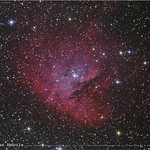An Examination of Habitability in Exoplanet Systems
DOI:
https://doi.org/10.58445/rars.14Keywords:
Astronomy, Planetary Systems, Exoplanets, Habitability, Kepler-62, TRAPPIST-1Abstract
By reviewing what is known and describing future research directions, this paper explores the qualities that make a planet habitable and the environment they may create. We consider two planetary systems — TRAPPIST-1 and Kepler-62 — and develop a metric to rank the likelihood of habitability on their respective planets. Our guideline for habitability includes the capability of sustaining liquid water, reasonable environmental conditions, and presence of molecules known to sustain life. Previous research has determined specific values and rankings within each system for planet density, obliquity, effective temperature (Teff) of the planet, equilibrium temperature (Teq) of the planet, and semimajor axes (among others) that increase the likelihood of habitability. After compiling these system properties from the literature, we rank the planets in each system based on their expected likelihood of habitability. The two systems are compared to demonstrate how differing environments might affect habitability. The rankings, system comparisons, and other information lead us to conclude that Kepler-62 f and TRAPPIST-1 e are likely the most habitable planet from each system. We compare these planets to each other and individually to Earth. We conclude by placing these findings into the broader context of exoplanet discovery and discussing future constraints on planetary habitability.


